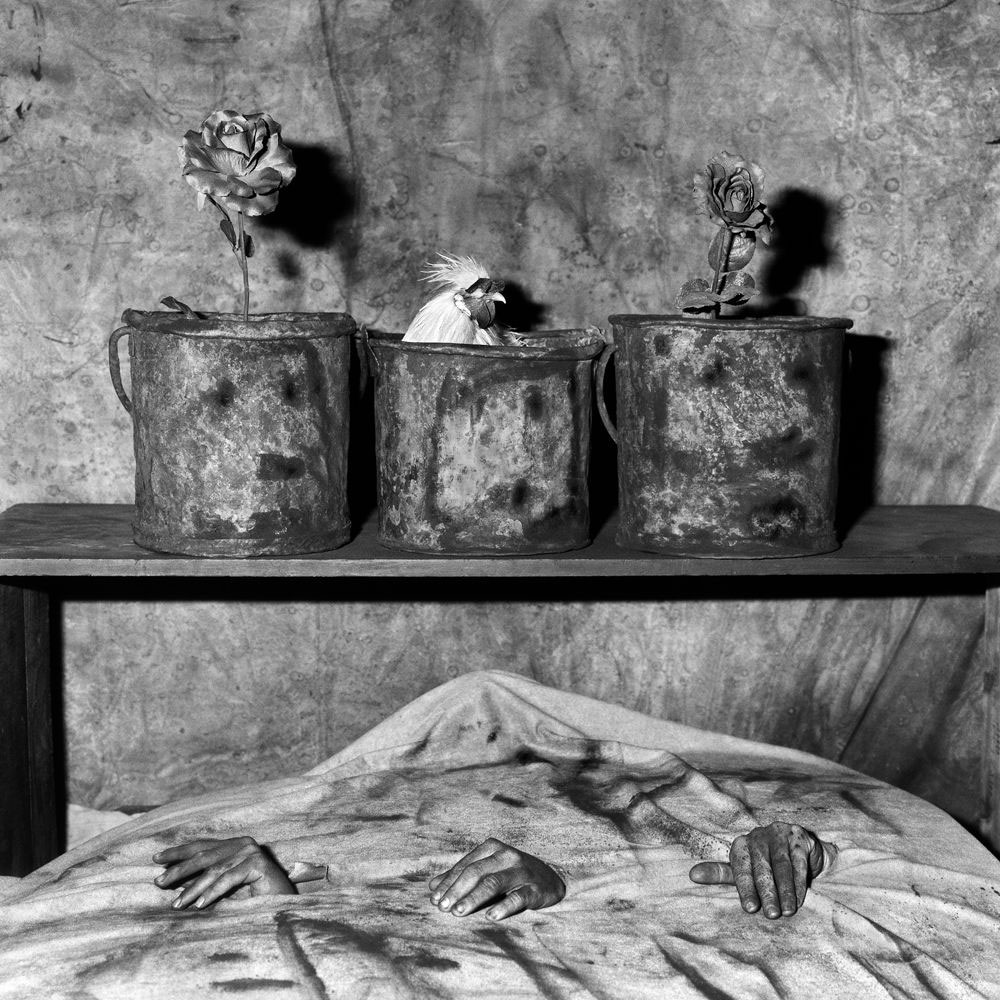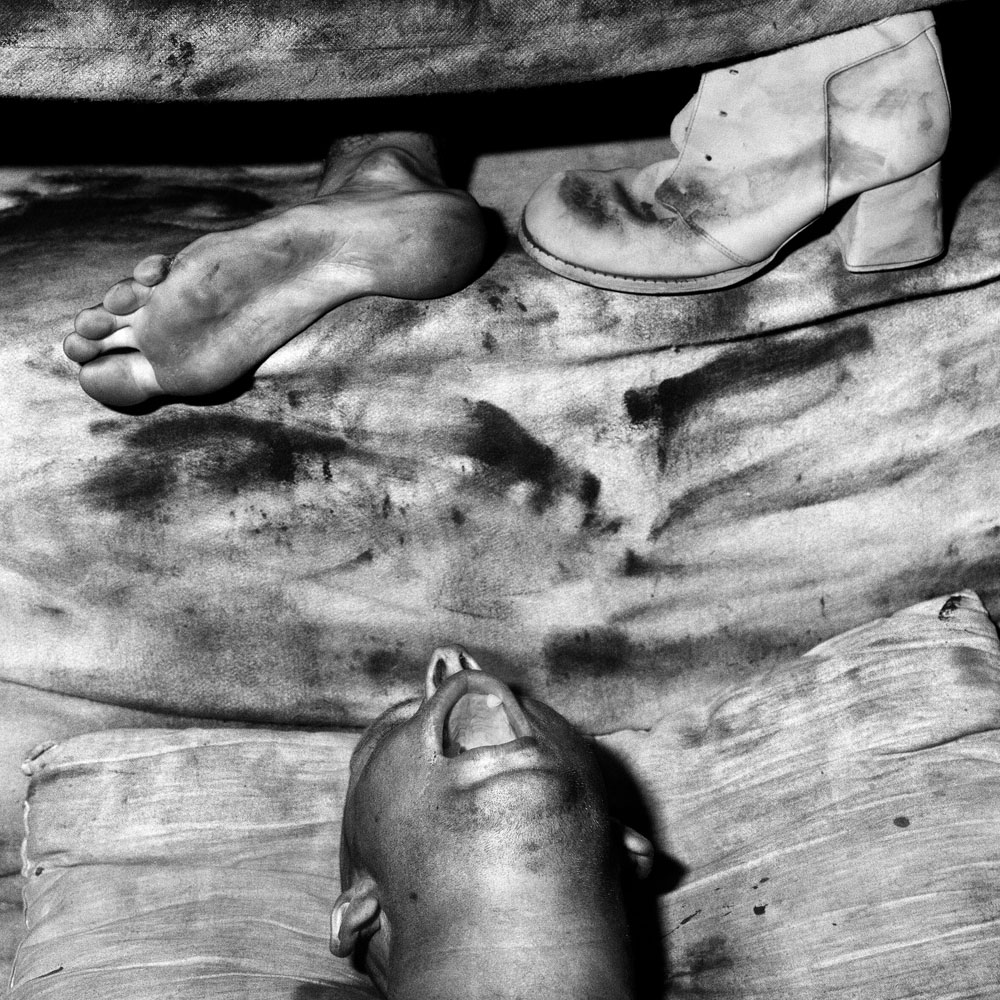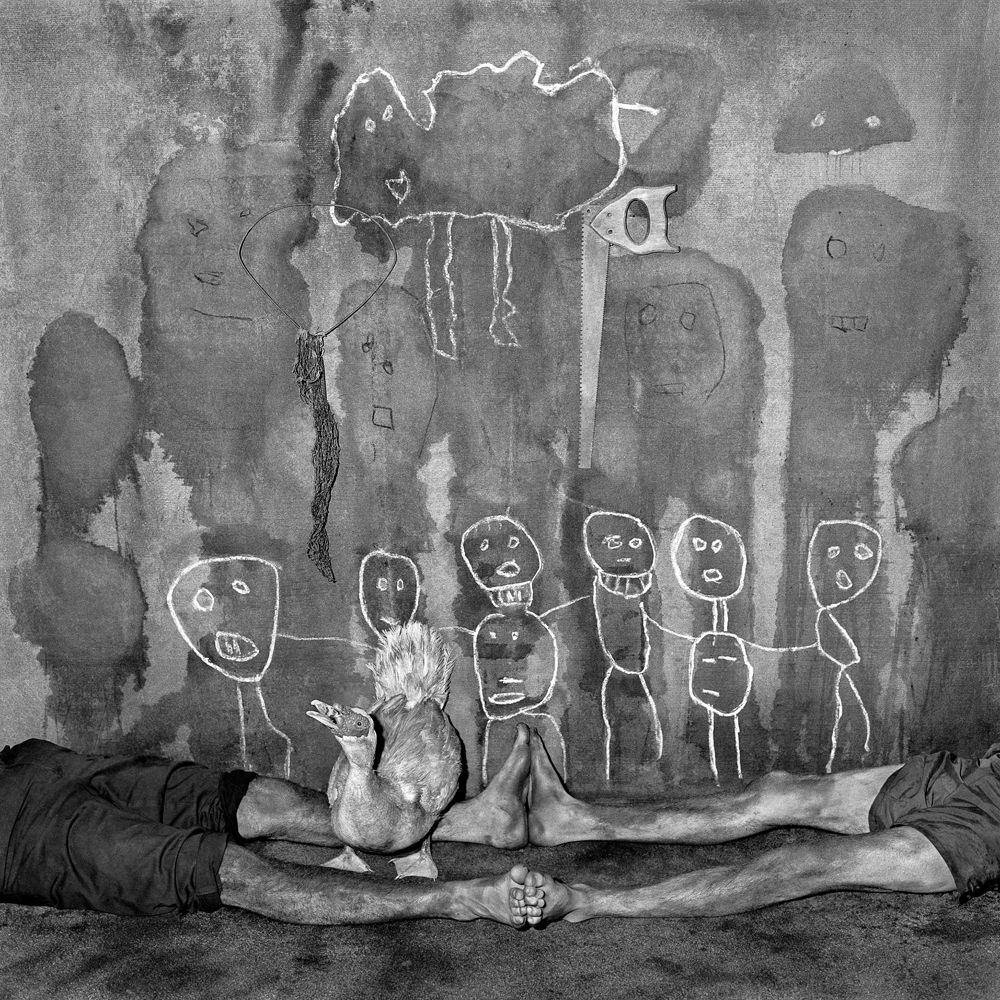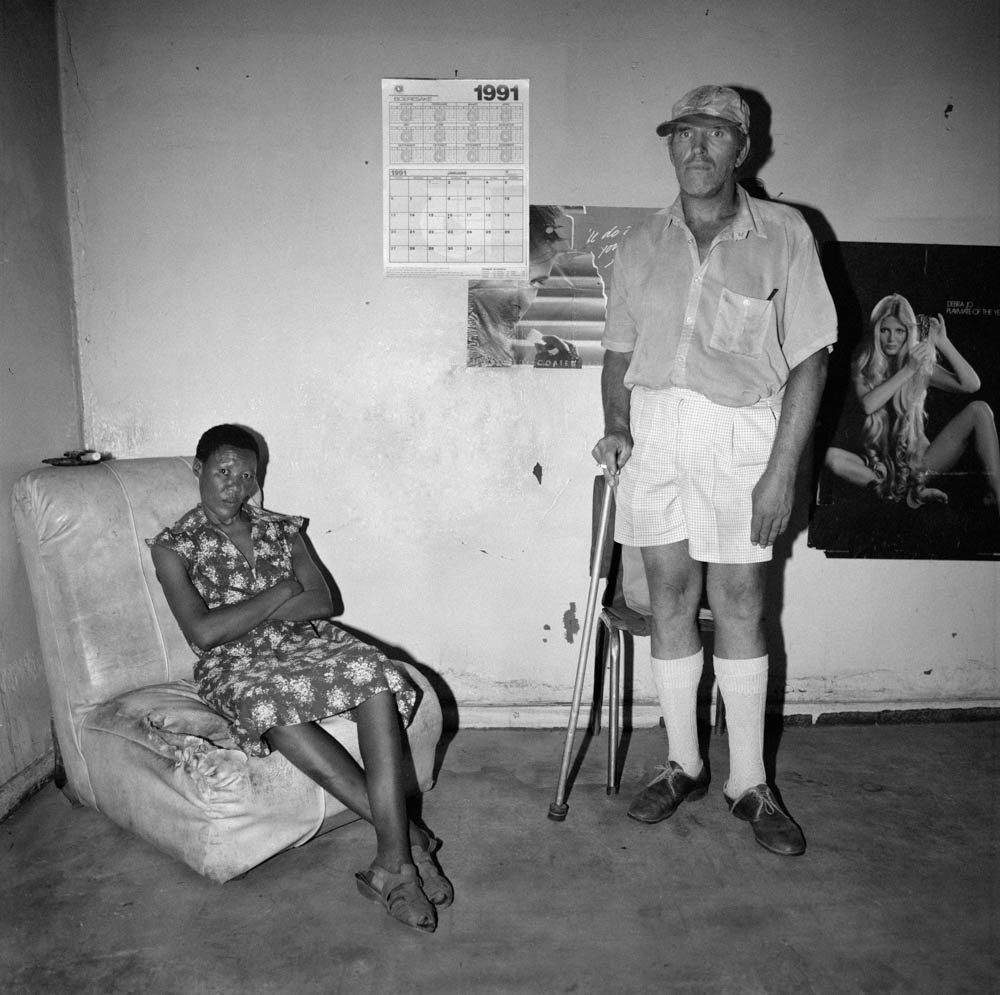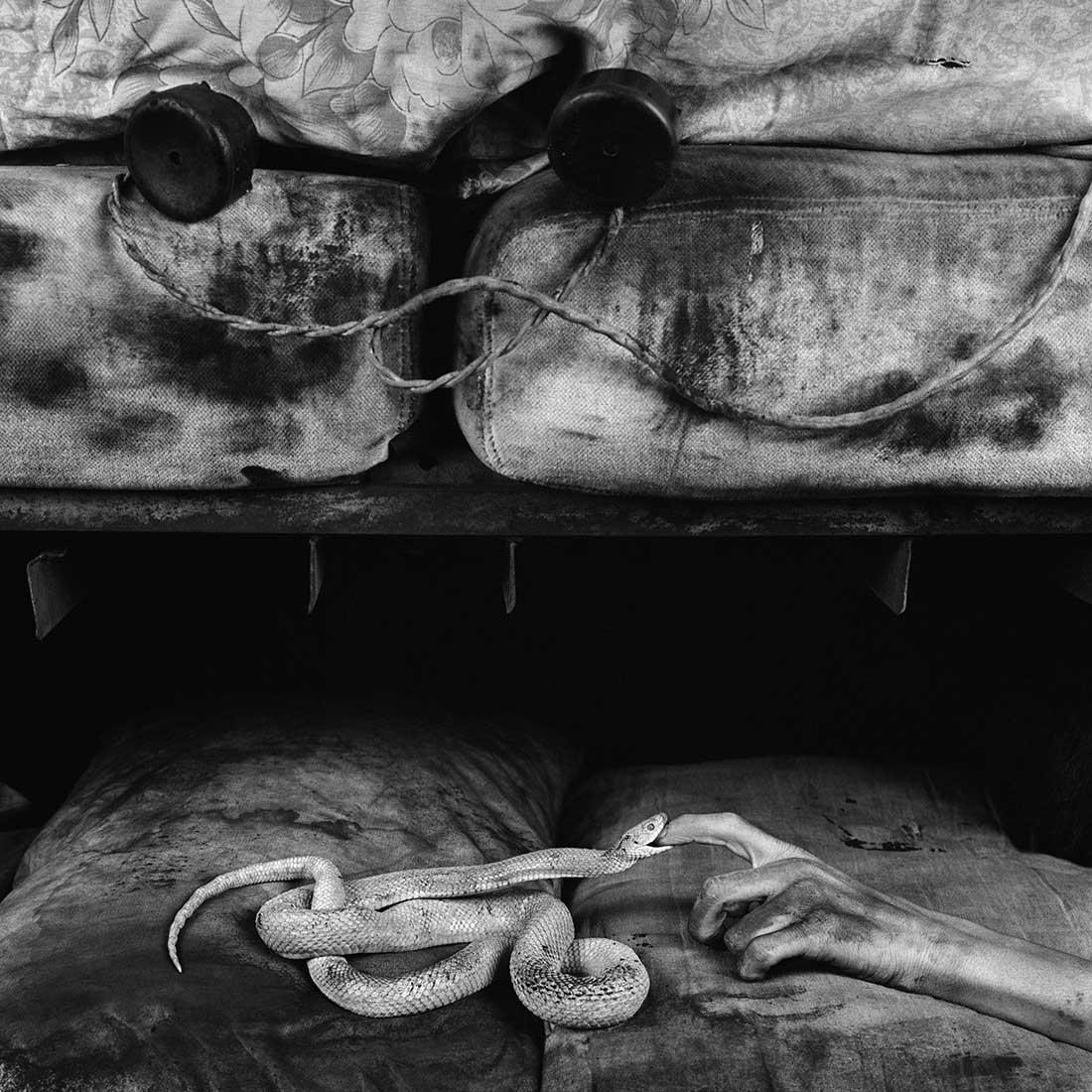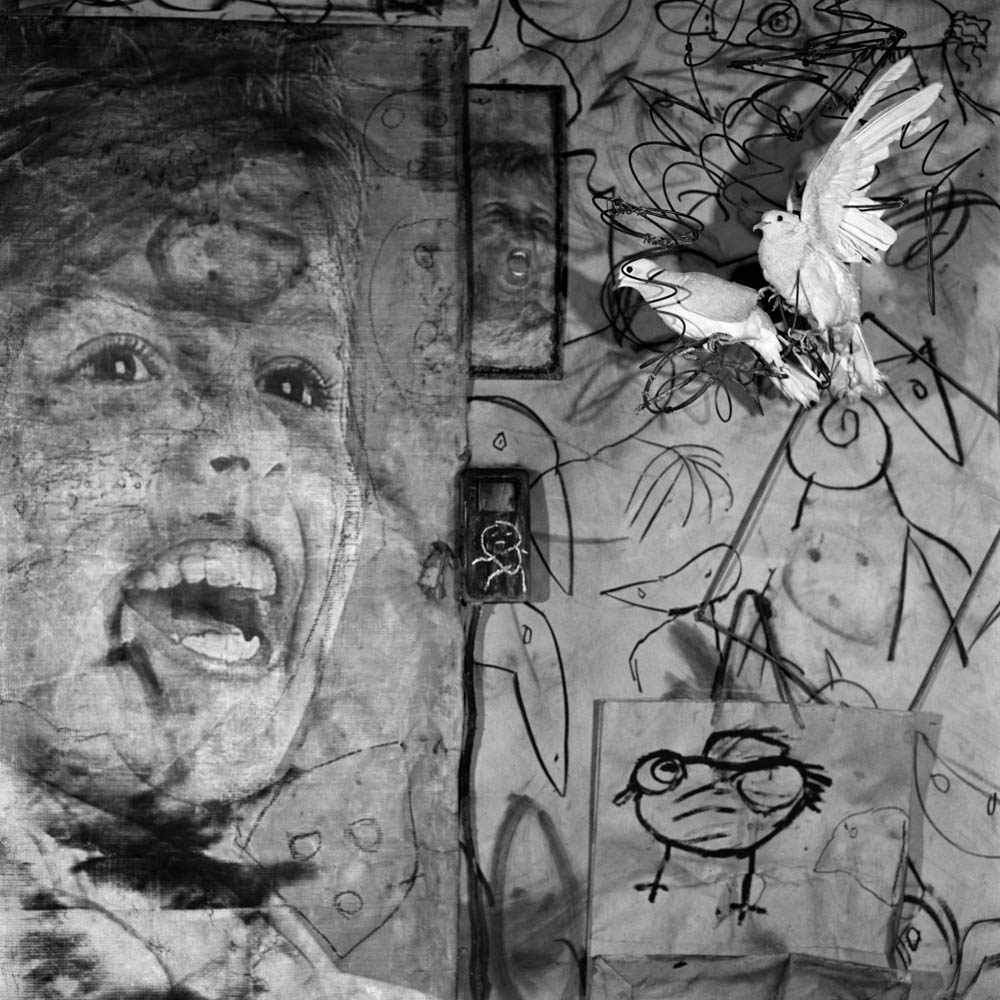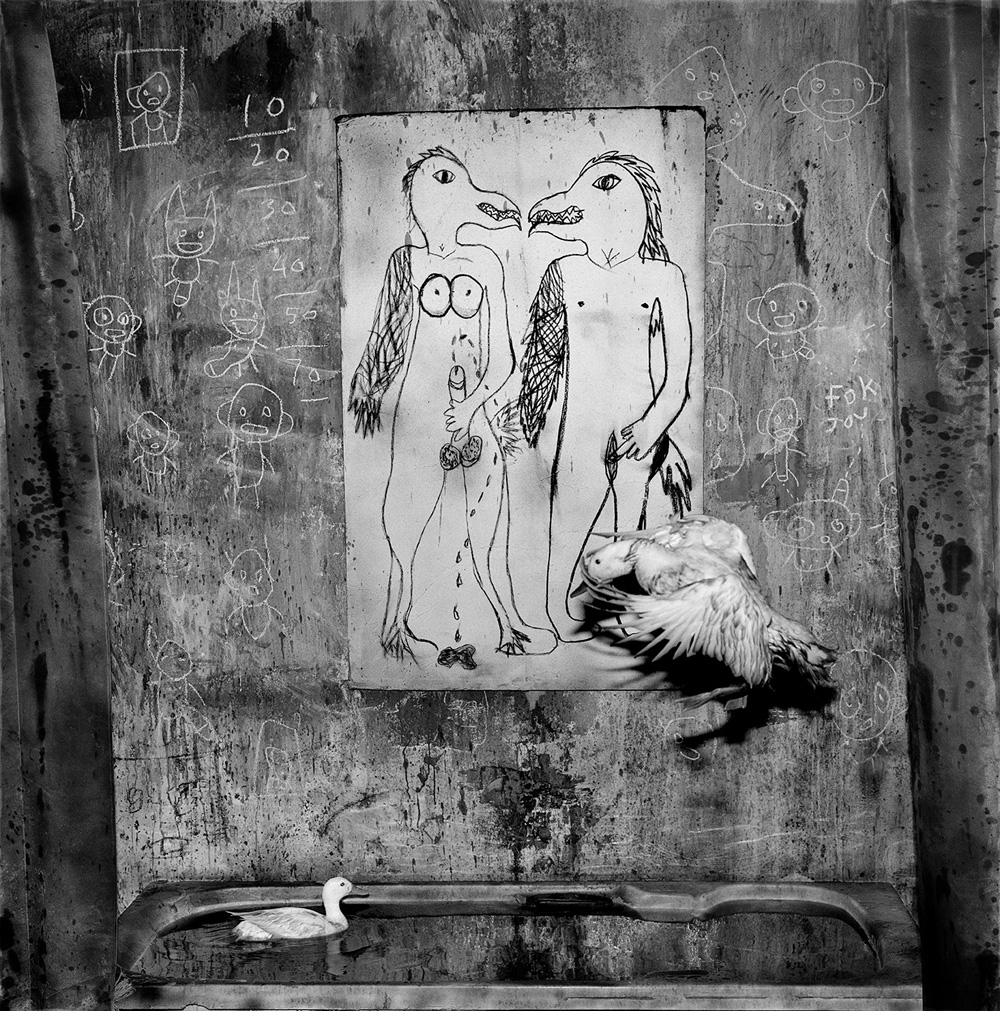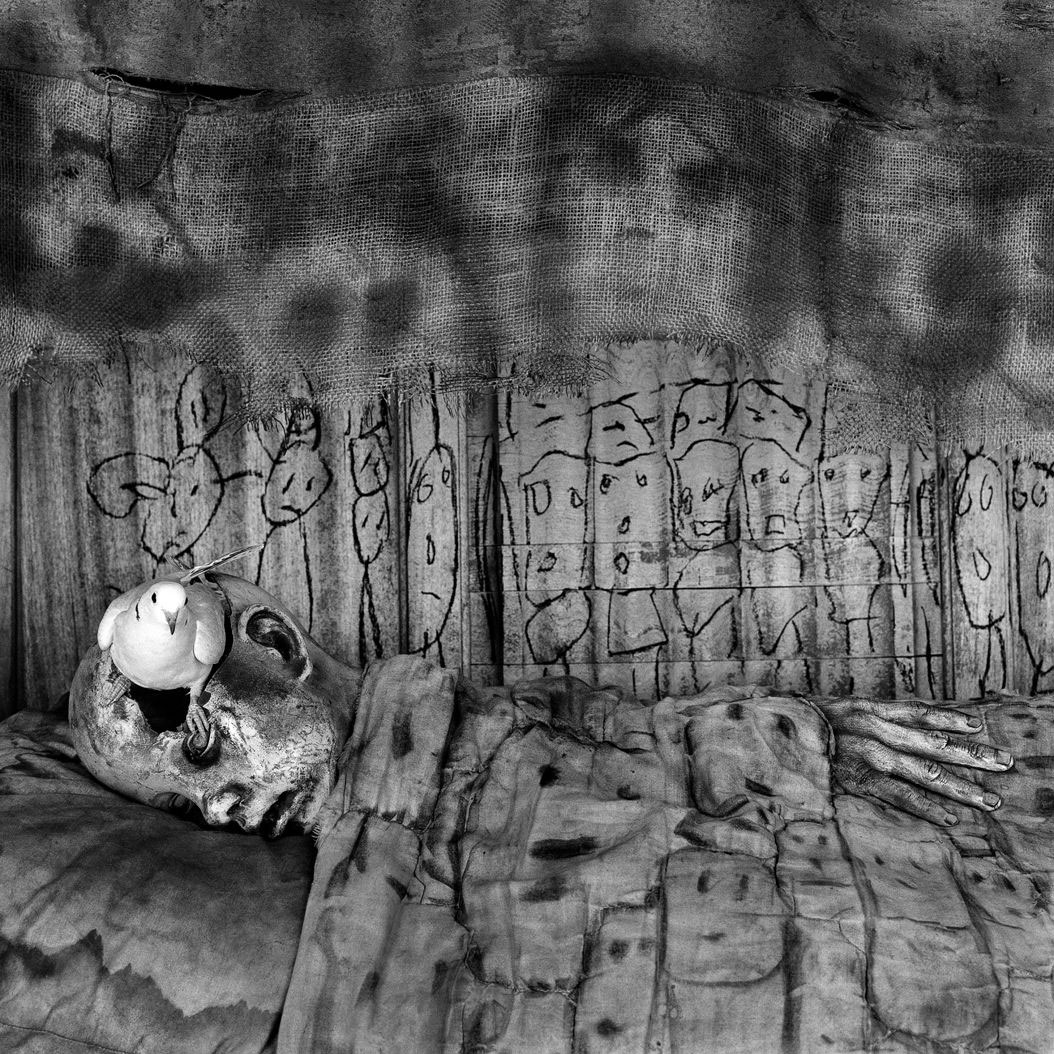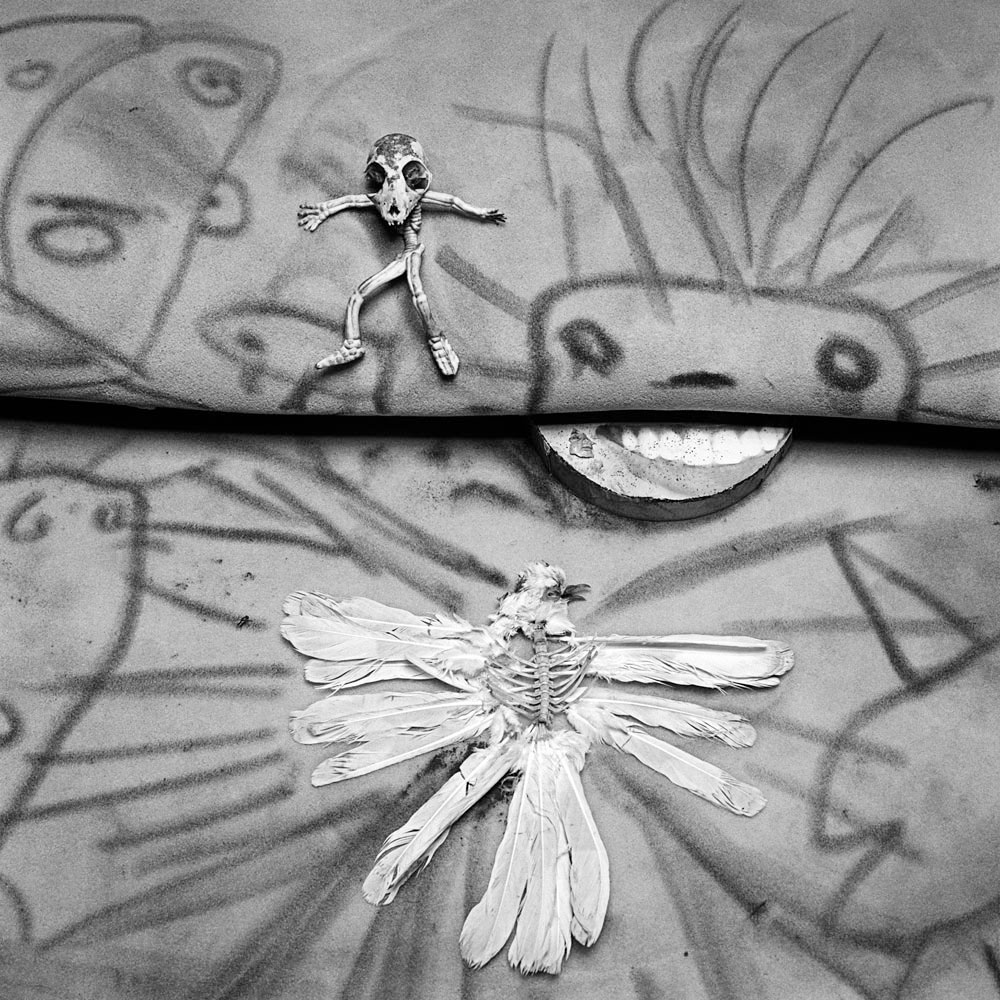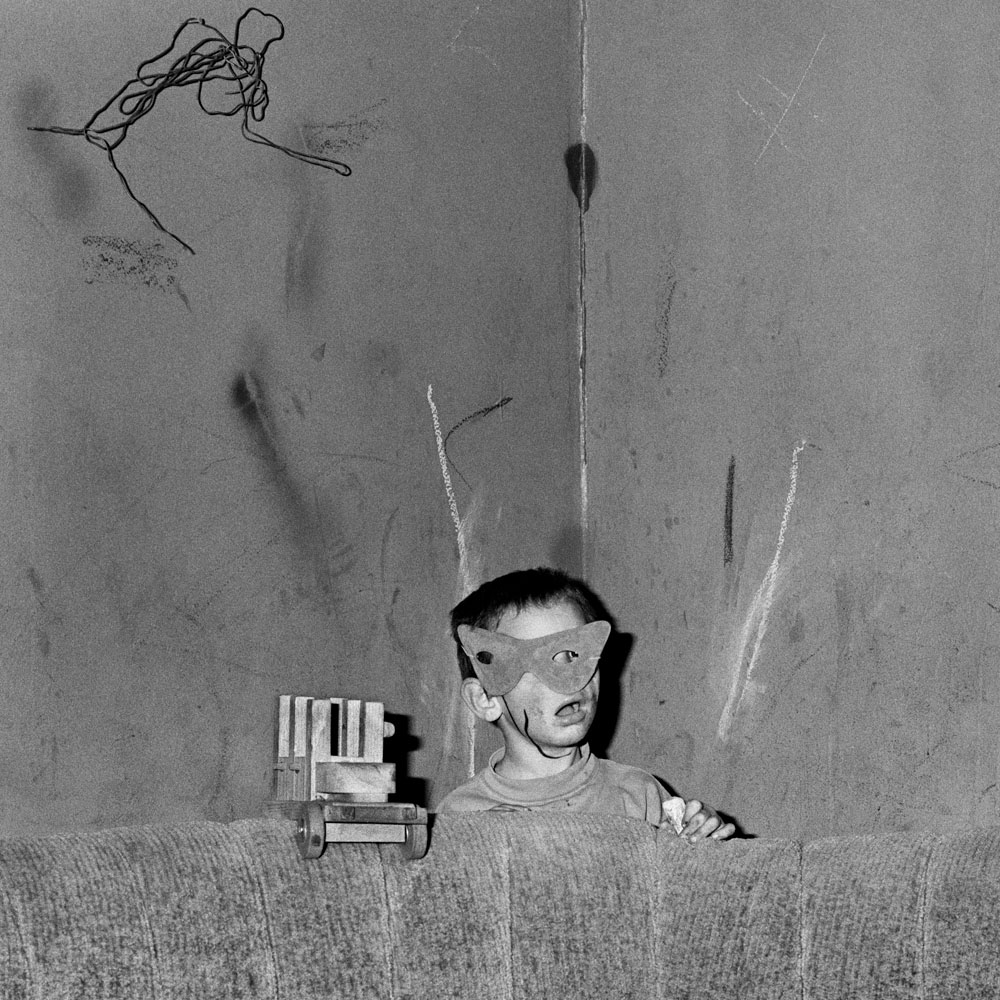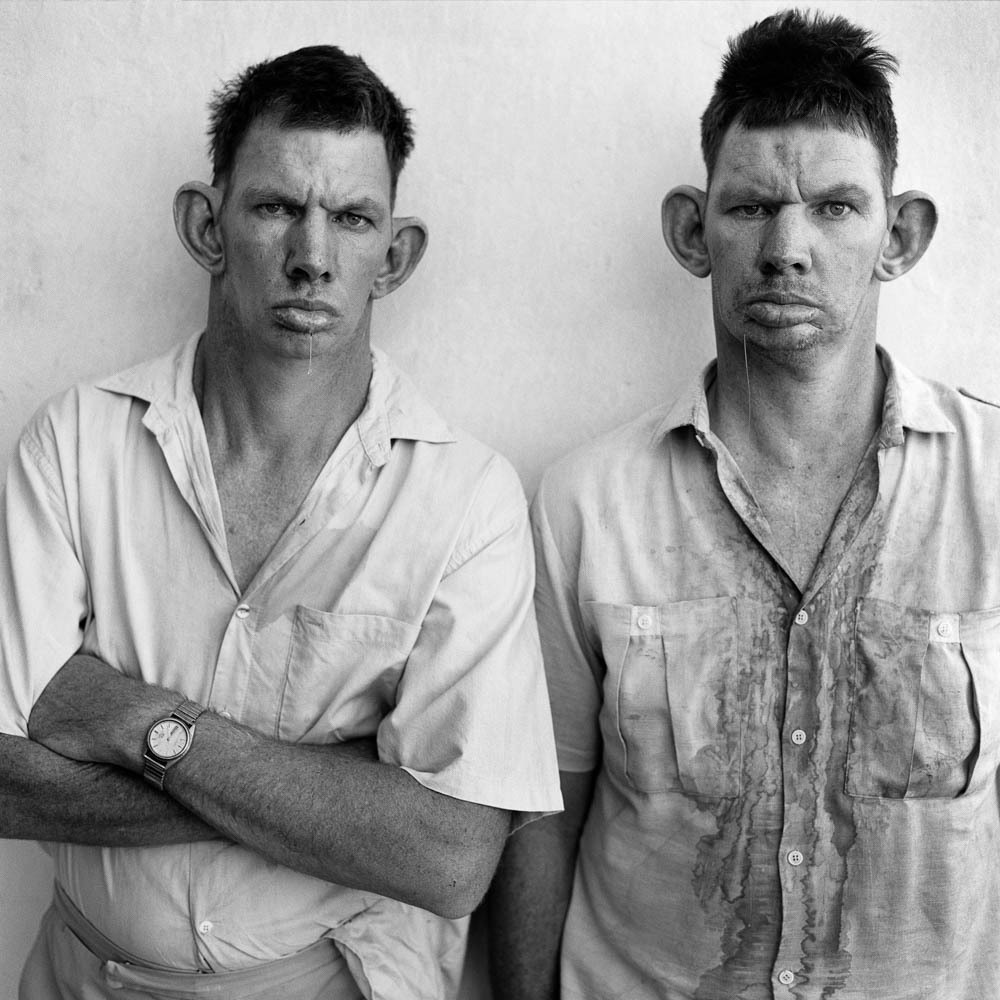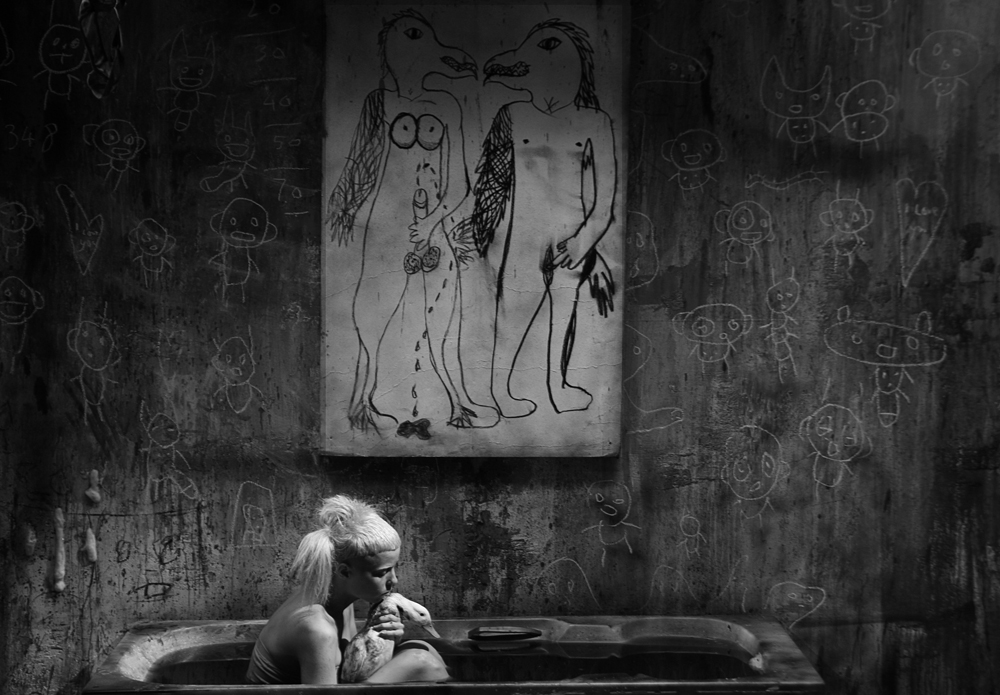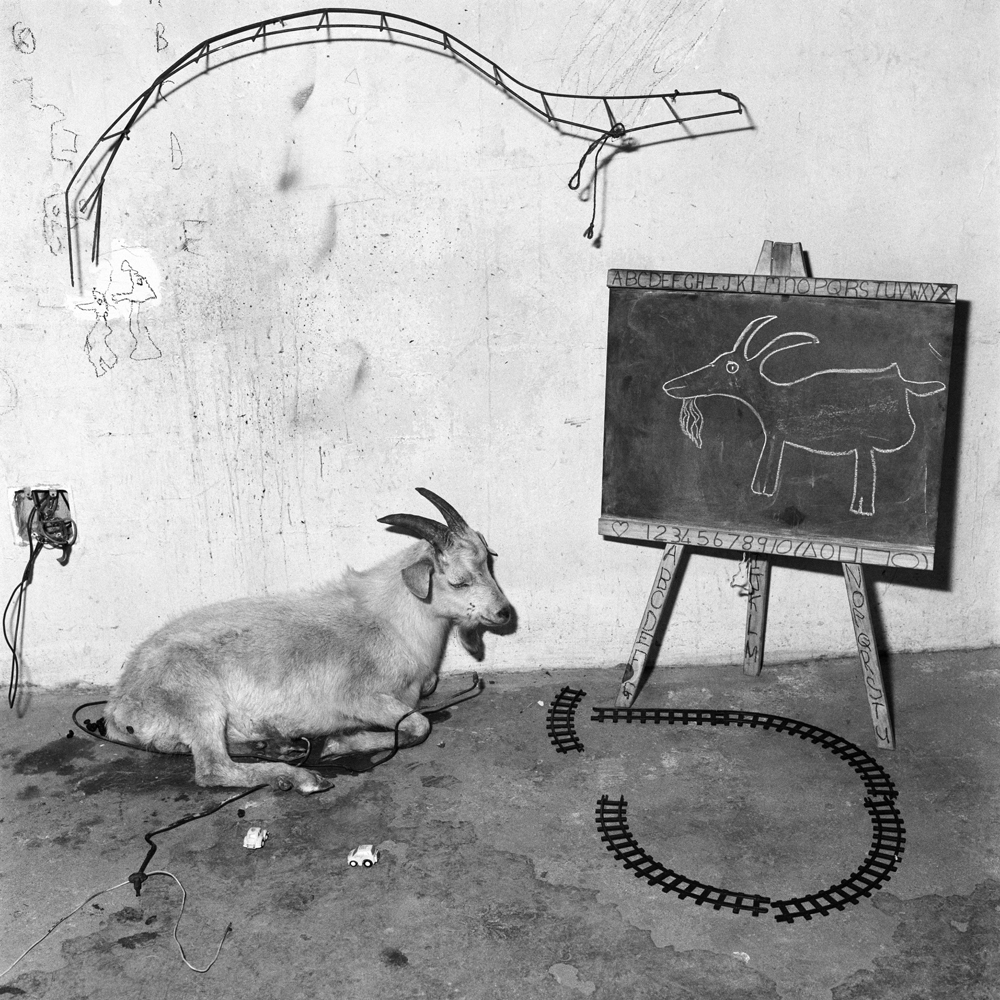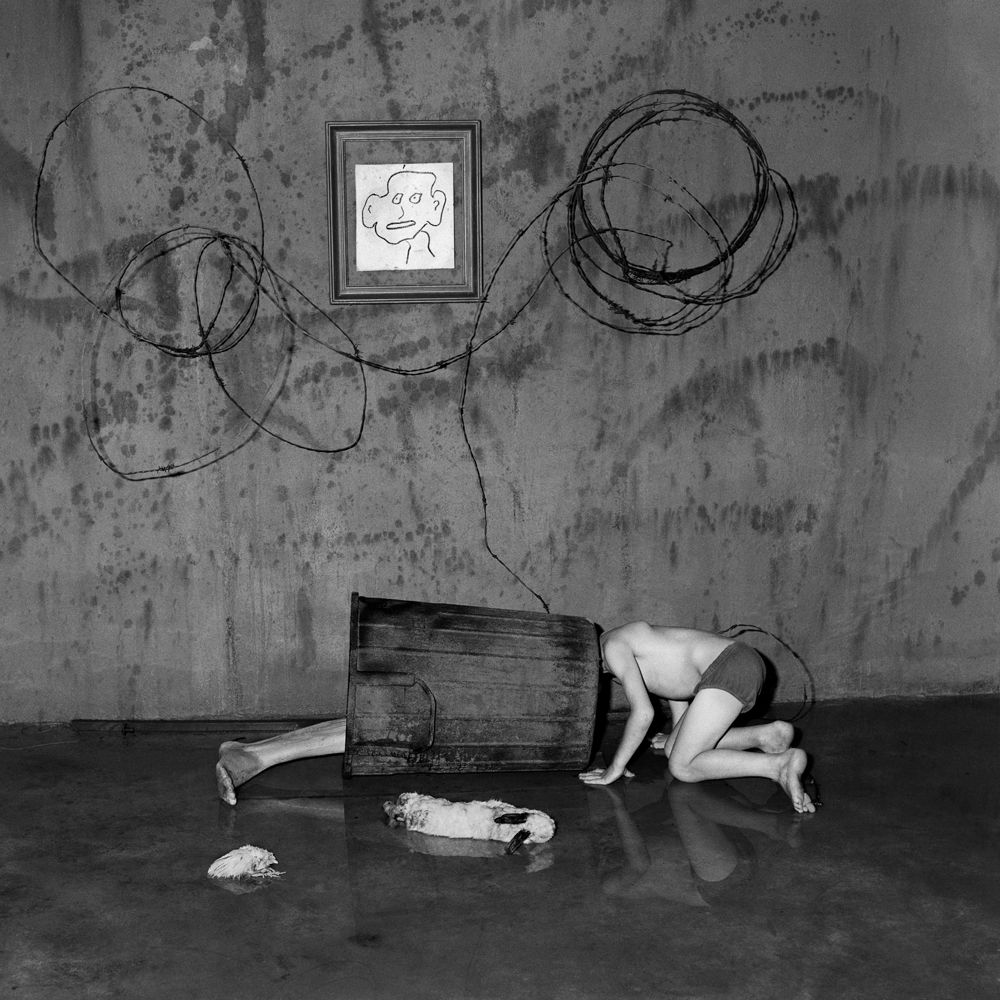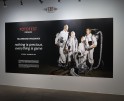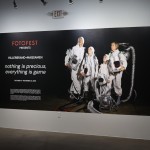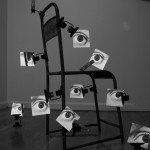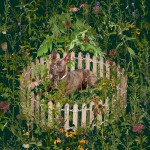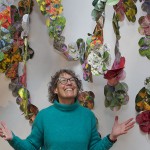Ken Weingart interviews Roger Ballen
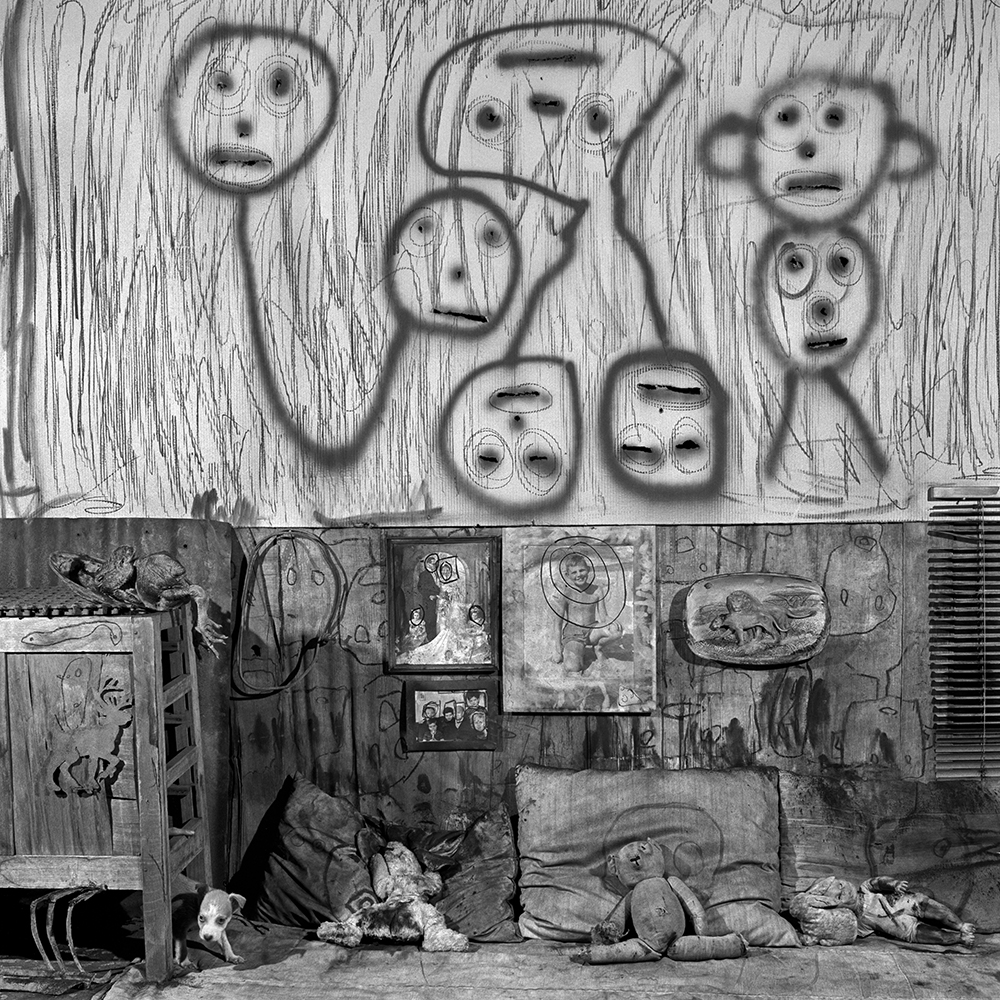
©Roger Ballen, Upseedaisy 2008
Today, we are sharing an interview that photographer and blogger, Ken Weingart conducted with photographer Roger Ballen. Ken has been producing interviews for his Art and Photography blog, and he has kindly offered to share a his interviews with the Lenscratch audience.
Roger Ballen is well known fine art photographer who has been creating exciting imagery for over 50 years. He has been widely exhibited in museums and galleries all over the world. His innovative work has created a new adjective in the Art world: “ Ballenesque”. In this interview, I had the opportunity to get inside the thought process of the artist and his worldview.
Where did you grow up?
I was born in New York City in 1950. I spent the first five years in New York City, and then I moved to Westchester until I was 18. Then I went to Berkeley in California and got a Bachelor’s degree in the late 1960s.
That’s a great era. What did you major in?
I majored in psychology at the time.
How did you like Berkeley?
Well, it was a great time because it was the period of the counter culture, so it was a very exciting period to be in Berkeley. It was a special time in the 20th century.
When did you get into art and photography?
My mother worked at Magnum in the 1960s, and started one of the first photo galleries in New York in the early 1970’s, and died, unfortunately, in 1973. She had been working with people like Cartier-Bresson and Streichen and some of the other Magnum people. This is how I actually got involved in photography because she was very passionate about it at the time. I was introduced to these photographers as a young boy. If my mother hadn’t been involved, I probably wouldn’t be in photography.
So, you met Cartier-Bresson and some of the others as a child?
Definitely. They came to our house quite often. My mother was friendly with them and helped them organize what they were doing. She was their assistant in some ways.
You went to South Africa for geology originally?
Yeah, I was restless. My mother had died, and I didn’t feel like being in the States. When I went, I thought I would just be away for two months. I hitchhiked from Cairo to Cape Town. Then I did a trip from Istanbul to New Guinea. I went back to America in 1978 and received a PhD in geology at the Colorado School of Mines. I then came back here permanently in 1982.
You became an artist around that time or a little bit afterwards?
I was always doing photography, because I did a photo book after that long trip. It would be interesting to mention in your article that Thames and Hudson Publishers is doing a retrospective book on my life in photography. I’ve given the book a lot of thought, and have written about fifty pages for it. I was sort of serious photographer from the early 1970; It was a form of expressing my viewpoint in the world. I wouldn’t call it artwork until probably about 1996. I see myself more as an artist. (The book, Ballenesque: Roger Ballen: A Retrospective, can be ordered here.)
Would you say it’s not until you did exhibitions and shows that you thought of yourself as an artist?
Look, when I did Platteland, the book was published in 1995. This became a famous book. It was a hobby until about 2004. So up until I was 55 years old, it was a passion and a hobby. Living in South Africa, you have no chance of selling photographs here in a millions years in any real way. I don’t like commercial photography. I started doing this on a more regular basis when Platteland was published. As I said, this book became quite famous with major shows and articles. I was very antagonistically received here in South Africa. But it generated a lot of publicity and fame, which gave me confidence that I was actually doing something that effected people. It was really a landmark in terms of launching myself into photography on a more regular basis. Beginning In 1995, I became much more focused and disciplined about taking pictures.
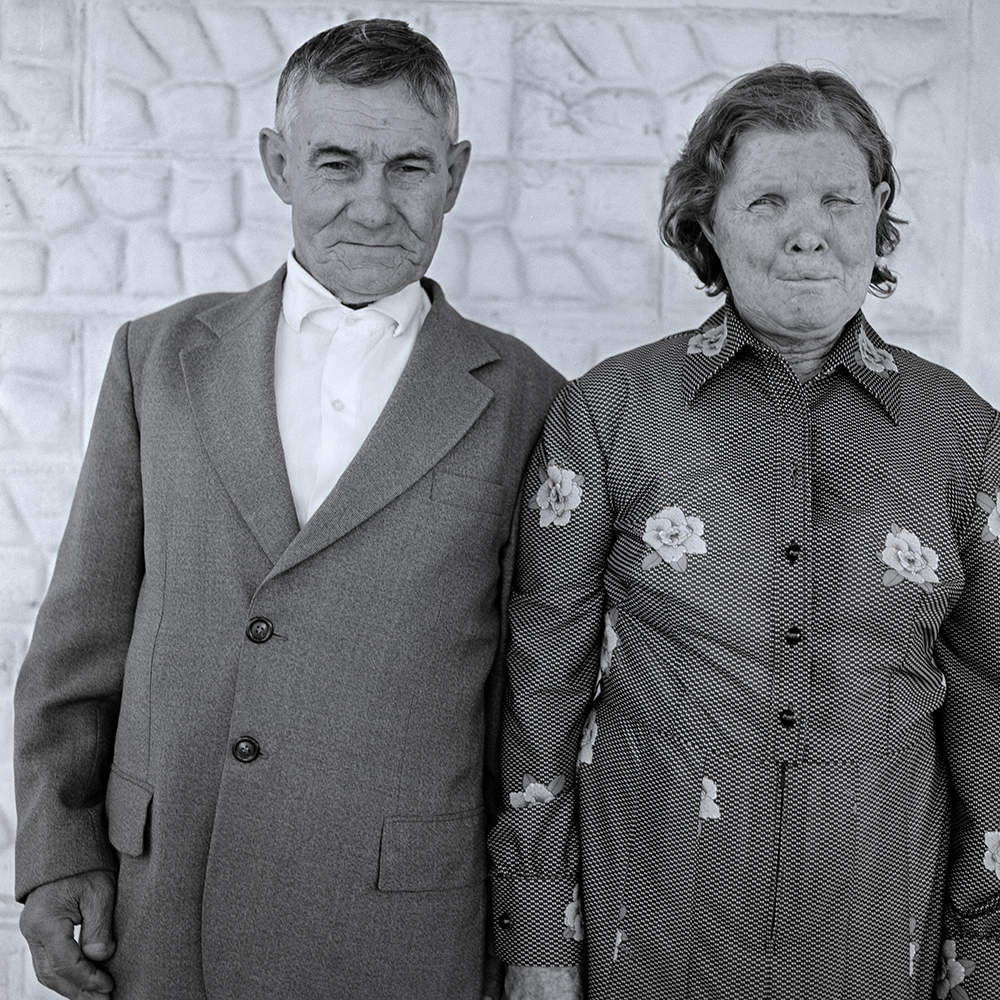
©Roger Ballen, Prison Warder and Wife 1986
Were you doing another job or career to pay the bills and make money?
I was doing geology from 1980 to 2005. So, that’s 25 years.
For a company, or a school?
I did it parallel. I didn’t stop doing photography. I’ve been doing photography in a passionate way but not as consistent as now. With regard to geology, it’s my own business. I had my own company, which was about finding minerals — gold, diamonds, copper, and nickel etc. I’ve been doing photography full time ever since 2005, but I would never have been able to evolve the way I did without the geology business. 99% of the people who as art can’t survive.
Absolutely. It’s very hard to sell art, especially photography.
It’s not an easy field. There are maybe five people in the world who sell at a very high price, and you have to factor what’s manipulated; what’s real and isn’t real.
When you do a series, what are you trying to achieve? How do you come up with your idea for the series?
Well, most of my series take about five years. So, you can start with that. These are visual concepts, invariable concepts. A lot of photography is about the unexpected happening during the time that you do the work. So, it’s not something that you can really predict. So, I don’t have any particular ideas about what I want to do. I want to go out and take photographs. I just relax and keep a focused mind and make the photographs. I don’t have any particular goals. I’ve always said that if you define my pictures with words other than enigmatic or mysterious, then the pictures are bad.
So it’s a spontaneous process?
Well, it isn’t spontaneous. It’s 66 years of living on a planet. There’s nothing spontaneous about that. It’s like saying being a great athlete is hard work, dedication, passion and maybe genetics. It’s a mixture of all these things. It doesn’t just come out of the spur of the moment. It’s a mixture between the conscious mind and the unconscious mind. There’s no way to describe the process in any concrete way. It’s a multi dimensional experience.
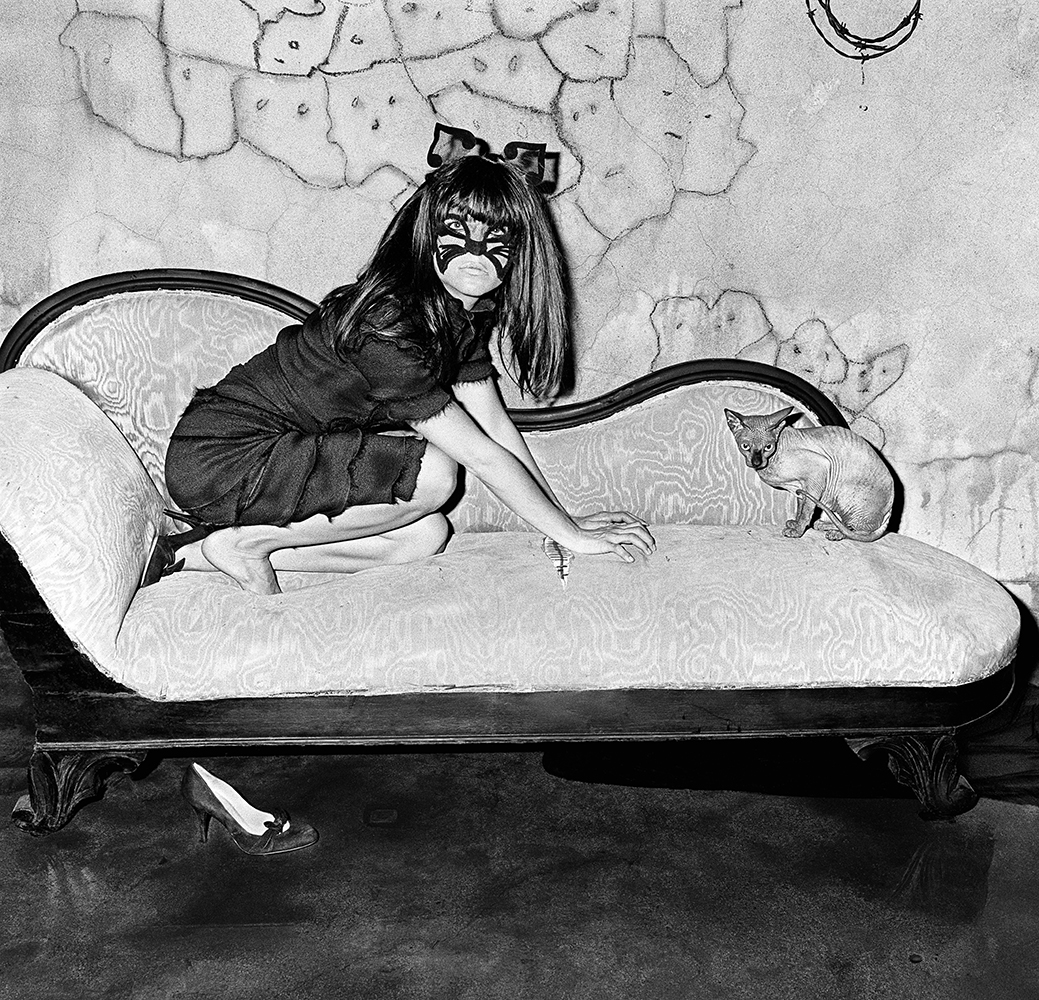
©Roger Ballen, Salma Blair, 2001
You use objects and animals: rabbits, ducks, rats, lizards, pigs. How did that come about?
Well I’ve been taking pictures of animals for a long time — about 30 years. I’ve always been interested in animals, very specifically the animal mind and the human mind. So, the relationship between the two has always been a major interest to me. I also do a lot of drawings of real animals and object animals. They came into my pictures even in the early days. But it started to really pervade the work in the book called Boarding House. And The Asylum of Birds was all about birds. So, it’s really come to the fore in the last 10-15 years.
For Boarding House you had a great quote, “it’s difficult to explain but I think it exists in some way or another in most people’s mind.” Can you expand on that?
With Boarding House, the feeling of the people and the place may have something to do with dreams and the subconscious mind some way or another. I mean I don’t know what’s going on in anybody’s mind. When people see my pictures, they often don’t forget them. I often enter the viewer’s subconscious mind to a degree they don’t forget. It implants itself. Why? I don’t know. No one knows why or how the brain works, and nobody can say. But certain art does that to more people than others. And my work does it to people a little more.
One reviewer of your recent video collaboration with Die Antwoord, said the work was the product of two warped minds. What is your reaction to that description?
This is a stupid comment. What does it mean? Are the people running major businesses or major companies normal people? Where does one see normality versus not normality? As far as I can see, the lines are very devious.
You made an interesting commentary once about what is ugly.
Well, that’s another thing. I mean it’s a subjective issue. What do we mean? I live in this culture here in Africa where what African people see as ugly or beautiful westerners might see as ugly. So, again most of what people see is ugly, especially in the Western world, is defined by media giants and economic forces and Hollywood. So the whole thing is garbage. The whole thing is based on all sorts of funny forces that exist out there for their own reasons. In Africa for example, fatness isn’t considered such a bad thing. A lot of people like fatter women. In Western society, it’s seen as bad. Here, it’s just the opposite. So, what is what? Here when it’s raining and it’s cloudy, they are all happy because there’s rain coming. In some other places, they’re complaining.
What is the main goal or motive for your series?
I only have one motive in my whole life, which is to find out more about the life of Roger Ballen. It’s a psychological journey for me. Hopefully the pictures have an impact on people like you and others and give insights. Hopefully, It helps people understand themselves, and impacts them in a positive way. But I can’t guarantee any of it. It has to start with myself. I just can’t go out and say, I’m going to help humanity and take greater pictures. That usually doesn’t work.
How do you usually find your subjects?
I’ve been working with people here for 35 years, so some people I already know. And some of my greatest photographs were taken in five minutes of meeting them, and some not. It’s never the same. Just knowing somebody doesn’t mean anything in photography because it’s a visual tool. It doesn’t matter what they say or what their history is.

©Roger Ballen, Diamond digger and son standing on bed 1987
Everyone finds people differently. Do you have a source?
You may be in somebody’s house and a friend comes in. You may be driving along and you see somebody and you like them. You may go to a house where a lot of people stay, and find a great background on the wall. I always say that the background, the things around the pictures is sometimes more important than the subject itself. Photography, it’s all about content.
People think, you just go and find an interesting subject and put it against the wall. 99.9% of the time, the picture made is nothing; it’s just a documentary shot. How do you create a complex view of the world? It’s putting thousands of things together. That’s why I said it’s not a spontaneous thing. It’s a very complex mental procedure to be able to take these pictures in the way I do. It’s not just the subject; it’s everything in the picture. A moth in the wall could be as important as a person.
Do you make sets and create the backgrounds by hand or just use found walls?
Sometimes they are there. Sometime ten people help me with the wall. Every time it’s an organic and different situation.
Can you speak a bit about Platteland Images from Rural South Africa, which was your first well-known book.
Well first I did Boyhood in 1978 in America. Then I did Dorps in 1986 in South Africa. Platteland was my third book. At the time, it got a lot of attention. It commented on the poor whites in South Africa, which people hadn’t paid much attention to. But again, it wasn’t necessarily that I photographed poor whites. The real gist behind it was I made some powerful photographs. I can show those pictures anywhere in the world, and on many occasions people know nothing about the history or subjects. The history is long gone. We’re a black country here. Yet it still has a lot of impact on people. So, the gist of it is I made powerful images. That’s the reason why it got a lot of attention. If I just photographed whites with holes in their shirts, it wouldn’t have had any impact.
Your first book came out in 1978?
I’ve been at it for 50 years now. 60 years of taking pictures.
Who do you respect or admire from the past?
Cartier-Bresson, Elliot Erwitt, and Andre Kertesz. They all played a role when I was in my teens, and early 20s. All these people played a role because my mother knew them. I learned a lot from them in my early days, and I emulated them in some ways. Later on, after I was about 35, I would say that there’s nobody, no person really that had any super influence on me. The thing that influences me the most is my own pictures.
Do you follow others artist?
I love Picasso, but I have to create my own style and learn from my own work. That’s what I’ve done. But the early days, the Magnum people and Kertesz and Cartier-Bresson, these people played a role.
Did you know or follow Diane Arbus?
I did know her because she came from New York. I don’t think she played that much of a role, on my pictures. I‘ve been aware of her, as I was aware of many other photographers.
And Joel Peter Witkin, do you know him?
I had a show with him last year.
So, you met him?
I don’t know him personally. I never met him.
Do you feel your work is similar to his?
I wouldn’t say similar; it affects people’s subconscious mind, in that it’s akin to surrealism and aspects of making statements that are dreamlike or half asleep and challenging. I think there are also some drawings of his work. I don’t really like talking too much about other photographers except that he’s a great photographer. But I think the esthetic is very different in a lot of ways. For example, my pictures have a lot to do with absurdity. I think his pictures seem to have a lot to do with religion, and I’m not really interested in religion. There are some similarities from a content point of view. There’s something very strange and real about them, something very subconscious. And he does drawings, so there’s that link.
On absurdity, do you mind giving a quick definition?
The terribly absurd: I guess that came about in the middle of the 1920’s, the concept that life is absurd, and that whatever you do is meaningless. There’s the concept of war coming and the idea that people are absurd. And people are involved in some sort of strange enigmatic theatre in my pictures. The questions are: what are they doing this for? What is the meaning? What is the purpose? Are they actors? Are they expressing something deeper about themselves and the human condition at the same time? And this is especially true with the Outland period of my work, around 1995 to 2000.
Outland was a very important book of mine in that I started to become an artist in my own mind. I feel like I’ve matured to a point where when you look at the work, there’s only one person who could have taken those pictures. So, I would say my later work, what some say is like the theatre of the Ballenesque, I have developed and worked hard on to get to for 50 years. The book won many awards, and became quite famous. When I did this book, people started to see that I was actually saying something in a different way, and I was taken much more seriously than before.
The recent series Asylum of the Birds is fascinating. When and how did the idea of working less with people and more with objects and animals come about?
This started a bit after Outland, about 2000, I started an interaction between portraiture and drawing. And people started to slip out of the picture. I still have people in my pictures now, but the portraiture really disappeared. The personality behind the person was not really seen as an important part of the picture.
Was there a reason you started using less people?
Not really. It was just a new step for me. The main thing is I started getting interested in drawing and still life. If you take a picture of a person, the first thing the viewer does is look at the person. I was getting tired of the same questions: who are these people? Do they like the pictures? What do they think? Are you exploiting them? Do you give them money? Do they see the pictures? You make them pay? Blah, blah, blah.
I do what I do, nothing more. What am I going to take pictures of? What should I do for the rest of my life? I think that separates me from a lot of other artists, because my style evolved quite a lot. So, there are several periods, and the periods are very distinct from each other. That’s Important to me because I’m not the same at age 66 as I was at 46. I might wish I had the energy that I had at 46, but I don’t. I have to deal with the things that are in my mind now, and some of the things have been on my mind since I was five years old. But a lot of things shift over time because of your own biology.
Performance and documentary are more to the fore now?
Not documentary but performance. As I said, it’s like a theatre. It’s not a documentary. Or maybe then a Ballenesque documentary. It’s not documenting anything except Roger Ballen’s world. If the viewer finds the pictures interesting, then it’s documenting his life too.
Do you have any preference on cameras through the years?
Since 1982 till now I’ve been using the Rolleiflex square dome camera. It was used as well in the recent project The Theatre of Apparitions, which is being exhibited at Hamilton’s in London. Some of the pictures are rectangular because I was still playing with a digital monochrome camera Leica gave me. In the last year, I’ve been taking pictures also with a digital camera.
That’s your first foray in the digital?
Yes, last year.
You held out longer than most?
Yeah, I’m surprised I didn’t give in. I remember telling people like you for many years that I really like film, which I do. I just think digital has gotten so good that the advantages are starting to outweigh the advantages of film, which I have to admit even though I don’t want to admit it.
So, you maybe you’ll be all digital in a few years?
There’s a good chance. It doesn’t really matter. The whole thing is what is the picture about. This is the thing. I’ve liked working with film for years, and up to recently it was better than digital. But it’s not better anymore.
What camera is the Leica?
Monochrome. it takes only black and white pictures.
And for lighting what do you use other than sunlight?
Since the mid-80s, all my pictures have been inside. Up to seven years ago, I put an immense flash on the side of the camera. But then in the last seven years, I started using bigger strobes separated from the camera because the detail on the picture is rather important. I couldn’t light up the detail with that small strobe.
And you are now using multiple flash heads?
Yes, multiple heads, usually at 45 degree angle.
Of your series, is there one that is a favorite?
I’m really reluctant to say one is important than the other. I always said that the Dorps (which was published in 1986), was the crucial period. That was an important series because I started to use flash inside. I started to find the motives I would use for the next 40 years with the square format. I started to meet some of the people that I work with, so this esthetic was born in these small towns of South Africa, in these homes. This esthetic you can also find it in Boyhood and even before Boyhood. It started to come about around 1982.
What is the backstory of the two white farmers with the big ears? Was it about abnormality and difference?
They’re twins. It’s a very famous picture. One worked inside and the other —the dirty shirt one—worked outside. Yeah, they were twins, and I guess, like everybody else, had certain issues to deal with. So, again, they were very powerful figures. I mean what is so great about a lot of people who are so normal? What is normal about people dropping bombs on villages a lot right now? Are they so normal? What’s so normal about people who go into cities in Europe and blow themselves up? What’s so great about them also? What’s so great about most things that happen?
Do you ever make political expressions in the art?
No, I’m only interested in the politics of the mind, how it will help one part of the mind talk to the other.
Not in the art.
I’m not involved in. The last thing I want to do is make political statements.
How did you end up directing the South African band, Die Antwoord’s, video I Fink You Freeky — which has garnered close to 100 million Youtube views?
The band contacted me in 2010. They said, wow, you’re amazing, you changed our lives, and we’d like to do a video with you. They basically said we’re a little mini Roger Ballen, so, they incorporated my esthetics in their performance. We kept in touch with each other, and did a video and put it on Youtube, and it just went totally viral. They live in Los Angeles now.
Are you interested in making more music videos?
I don’t know. I just have so much to do right now. I could do some more. People keep asking me all the time. It’s all a question of time management. I do so many things. My main focus is my own art. Do I want to work with 25 year olds and do music videos? Is that so important to what I do right now? That’s the thing. Should I be doing that, or should I be working on my videos for my Ballenesque project? Should I be taking my own pictures? Should I be travelling half way around to Los Angeles and make a video? You’re one person, you can only do so much.
How’s the gallery work going? You were with Gagosian for a while.
I was with Gagosian for many years, but right now, I’m not with them. I’m open right now.
That’s must be a hard world, straddling galleries and egos and everything?
The art market is unpredictable. It’s not the gallery. It’s the art market, and it’s not something that you can quantify or easily understand. It’s not something that makes a lot of sense.
Have you ever wanted to teach fine art?
I don’t do that. Occasionally, like in Los Angeles coming up, I’ll teach a two or three day master class. I mean I don’t have the time. I’m not 35 years old. I can’t spend all my time sitting in a university. I’ve got too much to do right now. There is no point for me to go to university at this age and spend time doing that. I’m focused on my own stuff right now.
How do you like living and working in South Africa?
I’ve been here permanently since 1982, so it’s been a long time. Like anywhere in the world, it’s got disadvantages and advantages. I think the biggest advantage is I was able to create the so- called Ballenesque esthetic. Let’s be clear: artistically it’s a bit isolating. It’s not in Paris, London, or LA. I basically work in isolation. My kids and wife are here. After awhile wherever you are, the world sort of will manage you. If you’re happy with what you do, and have your health, your family — this is what matters. It comes down to the same stuff all the time. You could be living in the nicest flat in Paris or London and not be happy. Life is not as clear as people make it out to be. I consider myself very lucky that I did what I did. I’m happy, and this continues to give me a lot of pleasure. I don’t know what would have happened if lived in LA or whatever. I may have gotten nothing done; I just don’t know.
Is South Africa an interesting place?
South Africa is interesting because it’s a first and third world country. It’s African and Western. So, you have these dimensions. But have those dimensions in Los Angeles too. This has a particular esthetic to it: It’s both first and third world. It had failed political issues, which was intensively debated for many years. All these things had some affect on me. But I can’t separate — I don’t know how to say — this is South African, and this is Roger Ballen. It’s impossible for me to say, to be honest with you. I mean I travel a lot. I see myself as a product of planet earth. I’m not nationalistic. I just see myself as a human being trying to deal with the human condition, my own condition, and the condition of the planet.
Most of your work is black and white, but you have done some color work?
No color. I’ve taken color pictures, but all my famous books and all the pictures that are on the market are all black and white. I’ve recently done a little bit of color, Polaroid color. Leica gave me a mirrorless camera. In the last six months, I’ve taken some color pictures, a few things here and there, and I’ve actually found the pictures to be quite interesting to my surprise.
Why have you had the preference for black and white for so long?
I think the reason is first of all, that it’s an art form. There’s no art form like black and white photography. The second thing is I grew up in black and white. Also, the photographs taken with a black and white camera are very pure. They are very reduced. They are minimalistic. In a way, I can’t separate that esthetic from my photographs. I feel myself still pulled to black and white, but I was surprised how good the color was.
Why did that surprise you?
Because I didn’t have any experience taking color pictures. I never did it before. If you put me anywhere in the world, whether it’s LA, whether it’s China or anywhere in the world, I’ll still take good pictures. It’s like if you took Picasso, or any important artists, and put them in those places, they are able to still produce the work, because the work, unless it’s documentary, or even if it’s documentary, It comes from the mind; It comes from the brain. I’m self generating, so I don’t necessarily need the environment out there. It’s not that crucial to my internal process.
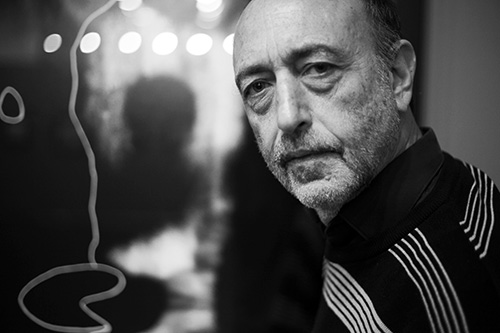
Photo of Roger Ballen by Ken Weingart
Posts on Lenscratch may not be reproduced without the permission of the Lenscratch staff and the photographer.
Recommended
-
Ricardo Miguel Hernández: When the memory turns to dust and Beyond PainNovember 28th, 2025
-
Pamela Landau Connolly: Columbus DriveNovember 26th, 2025
-
Interview with Maja Daniels: Gertrud, Natural Phenomena, and Alternative TimelinesNovember 16th, 2025
-
Robert Rauschenberg at Gemini G.E.LOctober 18th, 2025
-
Hillerbrand+Magsamen: nothing is precious, everything is gameOctober 12th, 2025

